Lux-RC FL33

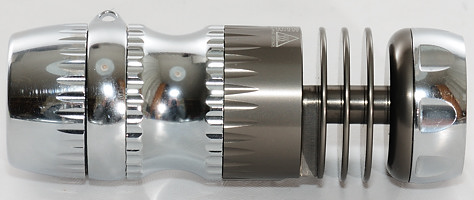
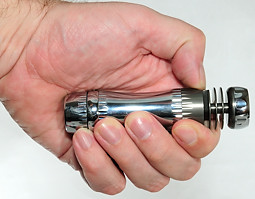
Lux-RC is a Russian company that makes some light products, in this review I look at their newest creation. This creation is a modular build flashlight, i.e. it can be ordered in many different configurations for both led, optics, light engine, battery tube, surface treatment. My copy of the light is with a 11 watt light engine and 3 neutral leds, the body has chrome surface. The light is made of aluminum (6061-T6 alloy).
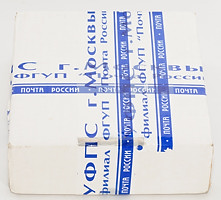

I got the light in a shipping box, this makes very much sense for this type of custom build light.
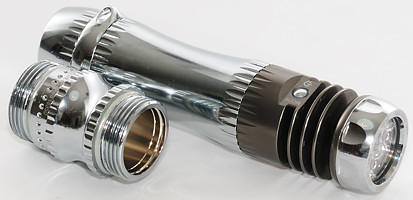
I did not get any extra, except two bodies, but later on the light will include extra o-rings, grease and lanyard. It will also be possible to buy clips, larger bodies and some mounts.

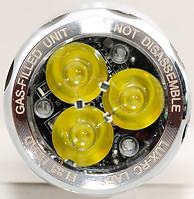

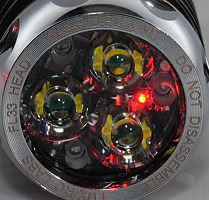
There are 3 main leds in the head they do not use a reflector, instead they have TIR optics. It is possible to order different leds (cool, neutral, warm) and different optics. Besides the main leds there is also a small red light that flashes about every 5 seconds for 0.012 second. This makes it easy to locate the light in the dark and does not use much power.
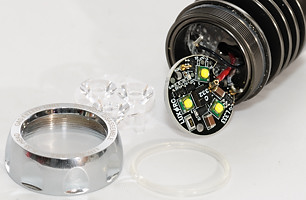
It is possible to open the head on this light, where the light engine is placed. This engine can be replaced with new versions, i.e. when a new better light engine is release it is possible to buy this as an upgrade to the light. It is not required to do any soldering to replace the light engine.
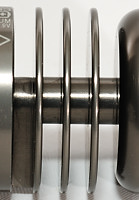
As usual on high power lights it has some cooling fins, but here they are larger than usual and an important part of the design.



The switch is placed on the head, just behind the heat sink. It is an electronic push button. Around the button is the battery indicator, when the switch is activated the ring will illuminate in a color for some time, the color depends on battery level. If the switch is activated just before the battery is empty, the indicator will flash for 15 minutes.
This indicator works both for one and two LiIon cell.

A fast press on the switch will turn the light on in the user adjustable mode, another press will change to high output. A longer press will turn the light off and a even longer press will change mode. The switch is a bit hard to press, i.e. a soft finger cannot activate it, a nail must be used.
It is a bit difficult to get out of the flashing modes again, it is necessary to either loosen the battery tube or step through all modes.
Note: This user interface is part of the L333 light engine and will be changed in the future.

This curve shows what happens when the switch is held down in adjustable mode, first the light turns off. If the switch is held down for some more time it comes on again and starts ramping up and down. Release the switch somewhere in the ramp and the brightness is remembered as the new setting.

The head also has some markings with the serial number, battery voltage, etc.. The warning about "Hot surface" is very real on this light, when running on full power it can get very hot (See my temperature curve). The serial number can be checked online to get the exact specifications for the light: Specifications for review copy.
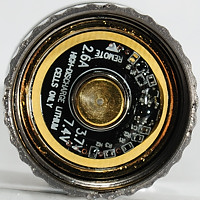
The battery connection in the head is a spring with a gold plated covering.
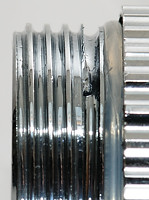
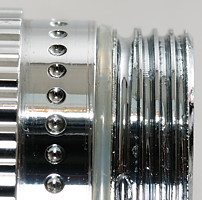
The battery tube has square cut threads and the two ends are interchangeable.
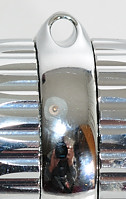
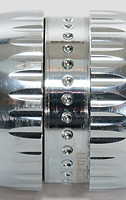
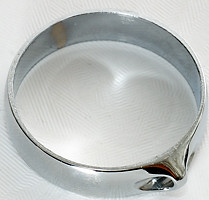
A lanyard holder can be mounted on the body.
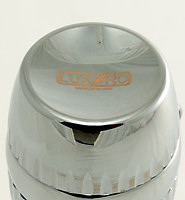
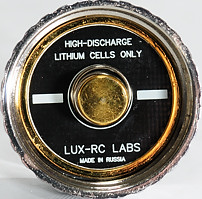
The tailcap is concave and the light can easily tail stand. The tailcap has a covered spring for the battery connection.
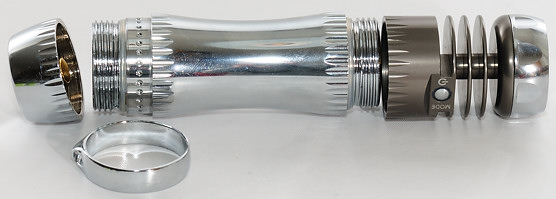
Here is all the part the light can be disassembled in without tools.
I like the idea of a user customable light and I also like the special design of this light. I got the light with neutral leds and combined with the high output this is a really nice flood light. As can be seen in this review there are a few detail that could be better and many of them are going to be fixed in the next generation of light engine (Called L334).
This light is to expensive if you want "just a flashlight", but if you like the design and want something more special, I believe this light is going to be a good candidate.
Technical specification and measurements

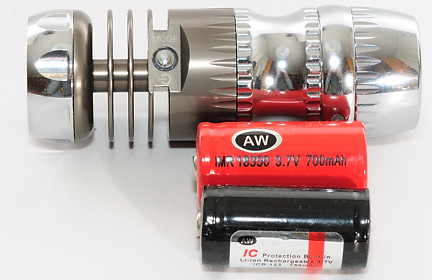
The light can use one or two LiIon batteries, in the short configuration this is one 18350 or 16350 battery, preferable IMR. In the long configuration it is 2x16350, 2x18350 or 1x18650, again IMR is preferred for the short cells. Because my light used a light engine without any battery protection I had to use protected 16340 when using two batteries.
This light does not have any problem with long, short or fat batteries. Both flat top or button top can also be used. The price for this flexibility is that the battery is a bit loose in the tube and can rattle.
Next generation of light engine will include battery protection, i.e. it will be possible to use two 18350 LiIon in the light.
Measured size and weight:
Length: 81.7 with 18350 battery holder and 117 mm with 18650 battery holder.
Diameter: 24.1 mm to 28.7 mm
Weight: 86.7 gram with 1x18350, 121 gram with 2x16350 and 131 gram with AW18650-26.
The light uses a 3 Cree R4-4C (neutral) led in the tested configuration.

In the above table I have collected all modes, measured at 7.4 volt (i.e. with two LiIon batteries). I have also included off as a mode, because the light uses a small amount of power. All the estimated runtimes are with a 2x16350 LiIon battery. The estimated lumen is scale from the specified maximum.
I could not select the exact same medium and low mode each time, in the above table PWM is measured at a probably slightly different setting than the other parameters. Default is the default user setting, when the battery has been removed for some time.
The light will soon get a new light engine, that is user programmable. This will probably invalidate many of my measurements.
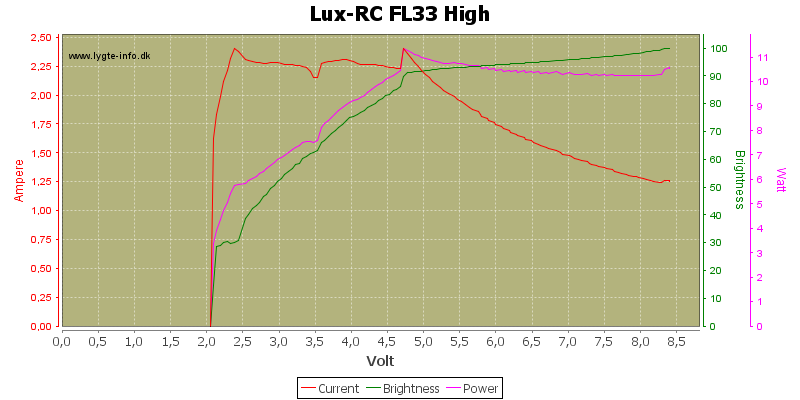
The first voltage sweep is done in high mode, the light has stabilization down to about 4.6 volt, i.e. it is not stabilization with a single LiIon battery. The dip at 3.6 volt is probably a battery low warning.
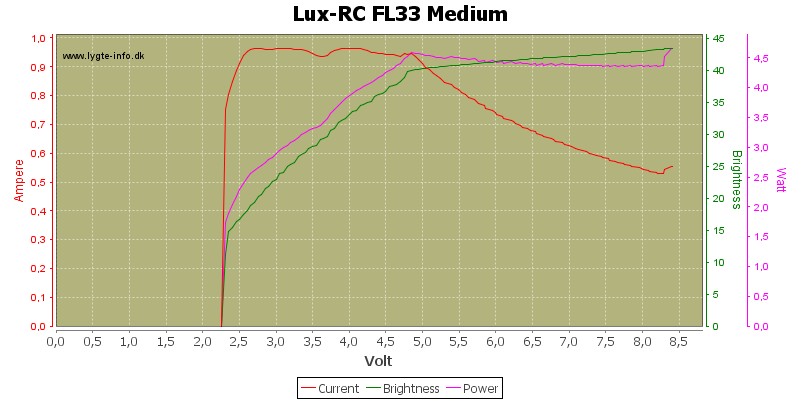
Medium does work exactly the same way, except it draw less current. When not running in high the pwm is audible.

The above curve shows runtime in the long configuration. As the voltage sweeps shows a single LiIon cell is not stabilized. The runtime with 2x16350 is also very short.
The 7 watt engine is stabilized with a single LiIon cell according to Lux-RC.
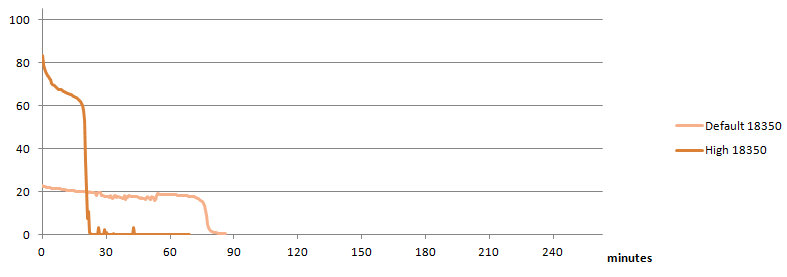
Using the short configuration, only a single LiIon cell can be used, here I am using a IMR 18350 cell. This gives a very short runtime, it would probably be wise to select a light engine with less power for this configuration (This is decided by the user when ordering the light).

I did a temperature test to see how well the light handles the heat from the led. When power is turned on the temperature rises fast, without any automatic reduction in brightness.
Note: My test does not simulate actual usage conditions, but are done on a test bench with only the head of the light and no cooling airflow, i.e. the light will get hotter than during normal use.
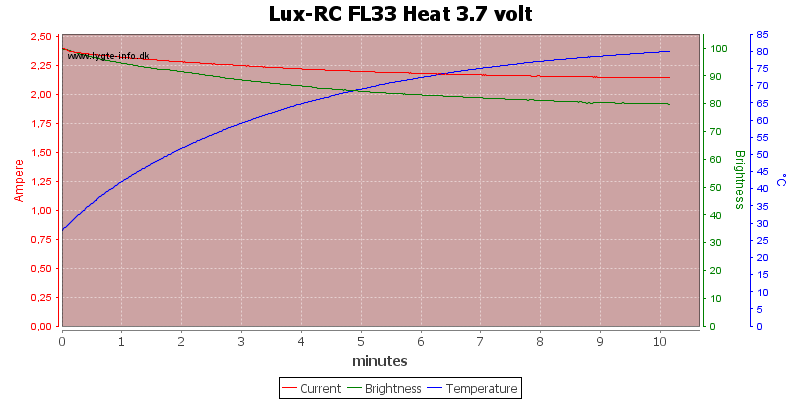
Same test, but with the voltage from a single LiIon. The temperature does not rise as fast, but it still rises fast.
This light must not be run without cooling on high!

The light uses pwm at about 1.3 kHz, this pwm in the user adjustable setting, but not in high.


PWM at the default and the low setting.

The strobe is at 10.4 hz with a 10% duty cycle. This gives a long runtime in strobe mode.

5 pulses and a short pause.

Two flashes each other second.

Sos, with a total time of less than 3 second to transmit, it is a very fast sos.

The sos has one problem, in the above curve I have filtered the pwm and as can be seen the sos fades, instead of turning off, this makes it more difficult to read it.

The beacon is one flash each 10 seconds.
Comparison to other Flashlights
Lux-RC FL33, Olight M21-X, Fenix Tk21 U2:

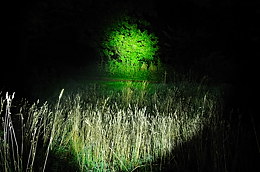
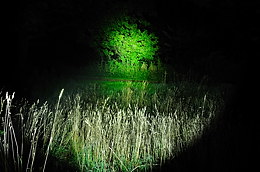
ThruNite Scorpion, ZebraLight SC600, Klarus XT10:
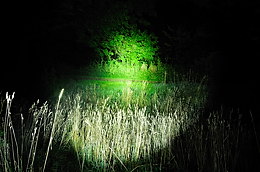

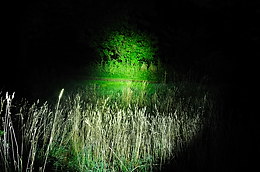
For the full comparison to other lights with graphs and beamshots see here
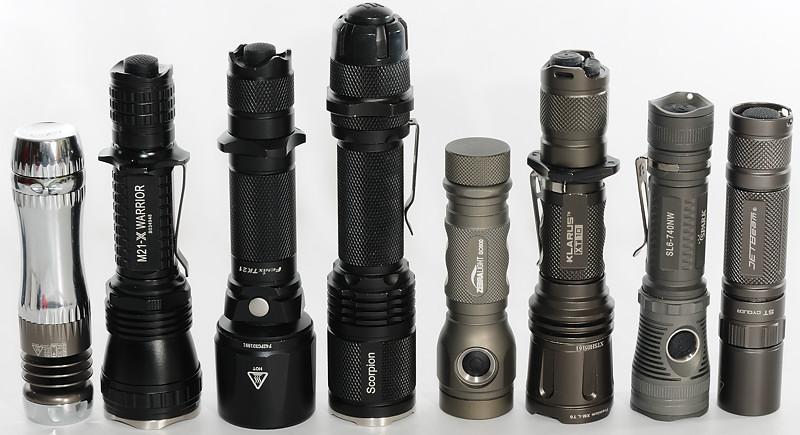
Notes
The light was supplied by Lux-RC for review.


















































